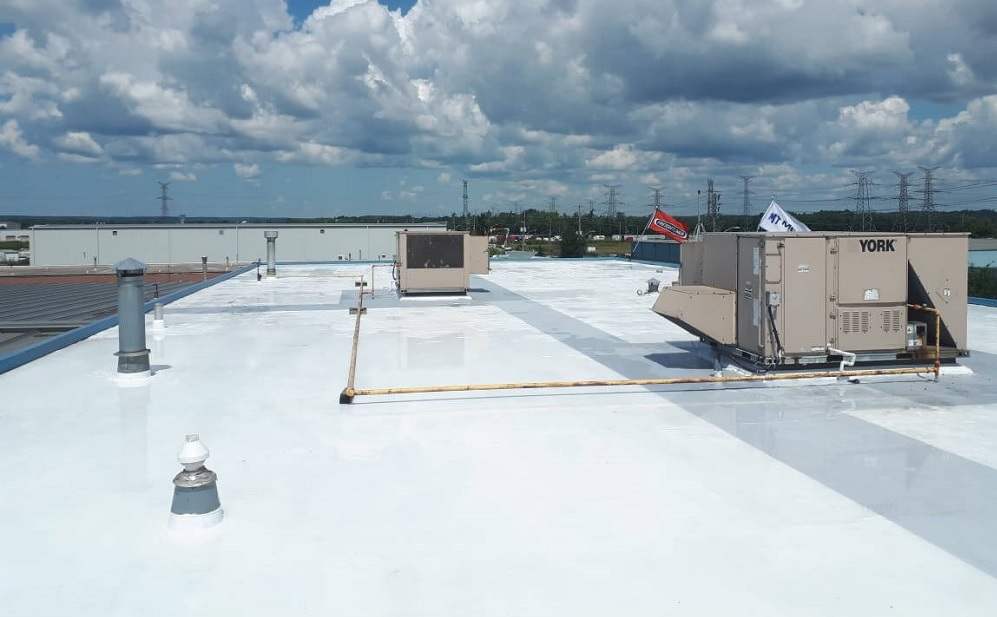The primary function of a commercial or residential roof is to provide protection for the property that in encompasses. Roofing systems can be customized according to the architectural design of the structure in question as well as to protect against potential damages, pests, and other issues. Commercial roofing in Canada follows a series of federal and provincial building codes to ensure the onsite safety of workers and property owners alike while also guaranteeing the structural integrity of the roofing system.
With proper maintenance, a durable and well-designed roofing system should last anywhere between 15-20 years before it needs to be replaced.

Many commercial properties have what’s known as a low or flat slope roofing system. Although these aren’t as common for residential properties, some apartment buildings, condos, and townhouses can also have them. Special protocols need to be taken into consideration in terms of the construction and maintenance of low or flat slope roofing in Canada.
Keep reading to learn all about the advantages and disadvantages of these roofing systems for your commercial property.
What Is Commercial Roofing?
Commercial roofing has to do with professional roofing systems that are specifically formulated for and applied to commercial properties such as factories, retail environments, warehouses, etc. These are structures that have unique roofing requirements compared to residential properties.
Generally speaking, commercial properties tend to be designed with a low or flat slope roofing system. The slope of the roof has to do with the degree to which the roof is slanted to allow rainwater and melted snow to run off the edges of the roof rather than collect in low or weak spots.
What Are the Advantages of Low Slope Roofing?
There are a lot of advantages to installing low slope or flat roofing for commercial and industrial buildings.
Improved Heating and Cooling
Compared to steep slope roofing systems, low or flat slope roofing systems result in less interior attic space, which means less hot or cold air is required to fill up the space. Low or flat slope roofing systems are therefore more energy- and cost-efficient since less excess hot or cold air is being expelled into the atmosphere. This is the perfect solution for businesses that are interested in minimizing their environmental impact and highlighting sustainability.
Easy to Perform Maintenance
It’s also a lot easier to uphold stringent safety standards during routine maintenance or scheduled roof repairs. Since the roof is completely flat, workers don’t have to worry as much about slipping and falling off in slippery conditions. They can be more surefooted while walking across the roof. Of course, safety measures like wearing harnesses and hard hats should still be in place to prevent physical injuries.
Low Installation Cost
Low or flat slope roofs are also a lot easier and take less time to install than steep slope roofing systems, which can save you a lot of money on labour costs and hourly wages. Plus, they also require fewer building and installation materials due to the straightforward design of the roofing system. Quick installation also means less downtime or operational disruptions for your business, which reduces financial and productivity losses significantly.
Offers a More Modern Design
Prior to the introduction of low or flat slope roofing systems, steep slope roofs were all the rage in terms of architectural design. Since the late 1920s, however, low and flat slope roofs have been adding a modern and unique aesthetic flair to commercial and residential structures across North America. While functionality is of the utmost importance for commercial and industrial properties, aesthetic appeal is also important to some degree because it helps your workplace stand out from other properties that are surrounding it, making it instantly recognizable.
Disadvantages of Commercial Low Slope Roofing
Just like any other roofing system design, low or flat slope roofs also have a few disadvantages that depend on your specific structural requirements.
Materials Are Limited
One of the main disadvantages of low or flat slope roofing systems is that they have limited materials available. Unlike slanted, high pitched, or steep sloped roofing systems, low or flat slope roofs don’t allow water to run off the edges of the roof. Instead, excess rainwater or melted snow has to soak through the roof materials since shingles can’t be installed on a roof that slopes lower than an 8.5-degree angle. Because of this feature, historically there have been only a few types of roofing materials that can be installed on low or flat slope roofs. Newer advances like polyurethane and polyurea coatings have broadened the landscape in regard to what can be done with flat and low sloped roofs.
Poor Drainage
Another important drawback of low or flat slope roofing systems is the lack of proper drainage. Excess rainwater or water from melted snow and ice typically doesn’t have anywhere to go unless the roof is at least slightly slanted. Hence, standing or pooling water is a major issue for most low or flat slope commercial roofing systems. Standing water is water that collects in one area and eventually eats through the roofing or building materials, penetrating the surface and several layers and causing potentially serious and expensive water damage including flooding. For this reason, most commercial roofs nowadays are designed with a slight, albeit barely noticeable slant to allow for proper water drainage while still maintaining a certain modern aesthetic. Polyurethane and polyurea roofing systems from IMC are excellent options when you have pooling water on your roof. These same products are used to waterproof pools, water parks and aquariums. Standing or pooling water on your roof is not an issue with these coatings.
Weight from Excessive Snow and Ice Buildup
Excess snow and ice buildup is a major cause for concern during the winter months for many Canadian commercial and residential property owners. Heavy weight from large mounds of snow and ice can actually cause a roof structure to cave in and collapse, leading to serious property damage and potential injury. Since excess water drainage is an issue for flat roofs, it’s important for commercial property owners to have a safe and reliable snow and ice removal contingency plan in place during the winter season.
Commercial Roofing Solutions and Maintenance in Canada
IMC Distributors is the proud partner of ISOMAT building materials and protective coatings across North America. As experts in the commercial building industry, we know that flat roofs in particular require durable and long-lasting waterproofing protection to prevent external elements from penetrating the surface and breaking down the structural integrity of the roof. IMC Distributorsprovides a series of polyurethane and polyurea protective coatings for commercial roofing systems to maintain their appearance and structural integrity for many years to come. Contact us today to learn more.
 Karli Logan is the Owner and President of IMC Distributors which is the exclusive partner of Nukote Coating Systems in Canada. With a B.Sc and M.Sc, as well as a demonstrated history of working across a number of industries, she has a passion to drive significant gains and benefits for IMC’s clients.
Karli Logan is the Owner and President of IMC Distributors which is the exclusive partner of Nukote Coating Systems in Canada. With a B.Sc and M.Sc, as well as a demonstrated history of working across a number of industries, she has a passion to drive significant gains and benefits for IMC’s clients.